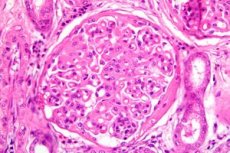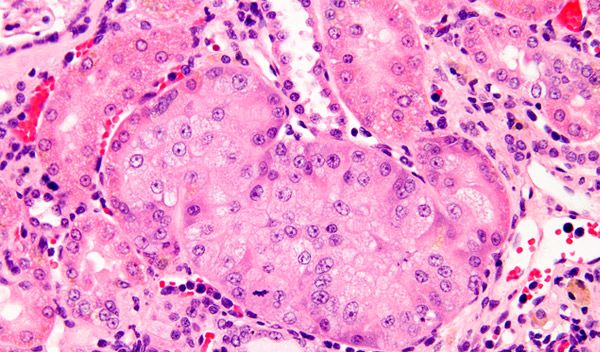Medical expert of the article
New publications
Kidney hyperplasia
Last reviewed: 04.07.2025

All iLive content is medically reviewed or fact checked to ensure as much factual accuracy as possible.
We have strict sourcing guidelines and only link to reputable media sites, academic research institutions and, whenever possible, medically peer reviewed studies. Note that the numbers in parentheses ([1], [2], etc.) are clickable links to these studies.
If you feel that any of our content is inaccurate, out-of-date, or otherwise questionable, please select it and press Ctrl + Enter.

The morphological medical term "renal hyperplasia" means an enlargement of one or both kidneys due to tissue proliferation. The increase in the number of cellular structures is not malignant: all the enlarged tissues have the correct structure and function. Why does hyperplasia occur? Can and should it be resisted? Does this condition affect the functionality of the organ?
Causes renal hyperplasia
Like any other painful condition, hyperplasia has its provoking causes.
One of the main reasons is frequent and prolonged inflammatory kidney diseases: chronic pyelonephritis, glomerulonephritis, etc.
The second probable cause is the absence of a kidney on the left or right, regardless of whether the kidney was removed or its function was stopped due to pathological changes. In many cases, damage to the kidney tissue can lead to hyperplasia.
Another cause of excessive tissue growth may be endocrine or neurogenic pathologies that cause cells to grow. For example, excessive secretion of hormones can affect the activity of renal structures, stimulating an increase in the organ's volume.
Symptoms renal hyperplasia
Specific symptoms of renal hyperplasia are absent in most cases, and organ changes are detected spontaneously during routine preventive examinations. In rare cases, the patient complains of minor pain in the projection area of the affected kidney: such pain may be accompanied by dyspeptic symptoms and increased body temperature.
Hyperplasia of the right kidney may be accompanied by a slight aching pain in the right lumbar region. When an infection occurs, the symptoms become more pronounced:
- increase in temperature;
- general discomfort;
- increased blood pressure.
The pain may gradually increase and spread to the entire surface of the lower back and back.
Left kidney hyperplasia may manifest itself as girdle-like pain, radiating to the left hypochondrium. However, in most cases, tissue proliferation is asymptomatic.
What is vicarious renal hyperplasia?
Vicarious hyperplasia is also called substitutional, since the tissue growth replaces the dead or removed kidney tissue. In this way, renal function is compensated: the organ that remains intact works harder, while simultaneously increasing in size.
Vicarious hyperplasia can be false or true:
- true hyperplasia is an adaptive response of the body to insufficient renal function;
- False hyperplasia is an excessive growth of fatty and connective tissues, which is a pathology and negatively affects the functionality of the urinary system.
True hyperplasia is a normal condition of the body, which allows the remaining kidney to compensate for the absence of a paired organ.
Diagnostics renal hyperplasia
Since in many cases renal hyperplasia does not manifest itself in any way, changes in the organ can only be detected during a diagnostic examination.
The doctor may prescribe several additional tests in order to identify the pathology and not miss the development of unfavorable processes in the kidneys.
- A blood test for creatinine allows you to estimate the glomerular filtration rate. If there is no pathology, this indicator is at least 90 ml per minute.
- A blood glucose test determines whether the blood vessels in the kidneys are damaged.
- A blood test for Urea Nitrogen (BUN) indicates the quality of the kidneys' filtering capacity, as it evaluates the level of residual nitrogen in the bloodstream.
- General urine analysis – indicates the presence of protein and also allows you to determine the pH level of the urine.
- An ultrasound of the kidneys is a study that can reliably indicate changes in the size of the kidneys, as well as determine the condition of the blood vessels.
- A biopsy is performed if malignant kidney disease is suspected.

Diagnostics carried out using the above methods allows us to determine the presence of hyperplasia and distinguish it from other diseases.
What do need to examine?
What tests are needed?
Who to contact?
Treatment renal hyperplasia
Treatment of hyperplasia is usually not carried out because in most cases this condition is functional and is considered a normal variant. If so, the doctor may prescribe only supportive therapy to facilitate the function of urine formation and the removal of fluid from the body.
If an infectious disease occurs against the background of hyperplasia, the doctor selects medications depending on the specific pathology and its severity. Patients with complex kidney lesions are hospitalized, and in other situations, outpatient therapy is carried out using such medications as diuretics and urogenital antiseptics.
Among the physiotherapeutic methods, the following are appropriate: applications of ozokerite and paraffin, electrophoresis, UHF, dry thermal procedures.
Prevention
It is impossible to prevent the hyperplasia process directly. However, we can all slow down the aging and deterioration of kidney function, as well as significantly ease the work of already overloaded organs. What should be done for this?
- Give up bad habits: do not abuse alcohol and do not smoke.
- Regularly monitor your blood glucose and cholesterol levels, and keep an eye on your blood pressure.
- Eat healthy food and drink at least 2 liters of clean water daily.
- Do not self-medicate or take antibiotics or anti-inflammatory drugs that are excreted by the kidneys without a doctor’s prescription.
- See a doctor in a timely manner and treat infectious diseases, chronic diseases, and also visit a dentist regularly.
- Avoid stress, strengthen your nervous system. Rest more, do active sports, toughen up.
Periodically, once a year, you can carry out preventive treatment with medicinal herbs. If there are no contraindications, such plants as madder, horsetail, and chamomile are suitable for preparing infusions.
Forecast
The prognosis for true renal hyperplasia is favorable. If this condition does not bother the patient in any way, it does not require any treatment. In cool weather, you should dress well to avoid hypothermia and not "catch" kidney inflammation. For the same reasons, it is necessary to avoid contact with patients with viral and acute respiratory diseases.
It is important to remember that any inflammation in the body can be complicated by pyelonephritis, and this cannot be allowed to happen with hyperplasia.
Of course, the diagnosis of "renal hyperplasia" does not mean that a person should completely change his life, but it is worth adhering to the above rules in order to avoid complications in the future.


 [
[